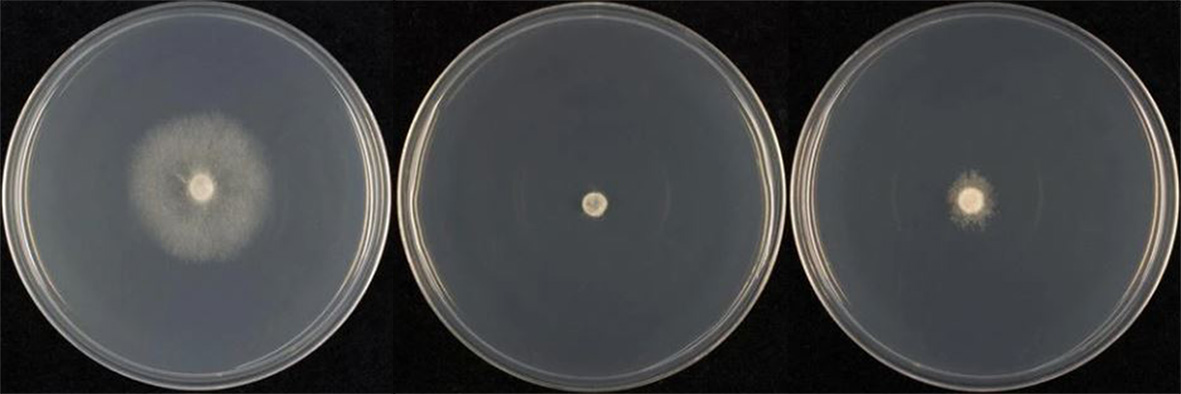Gallery
Image Type
Morphological Structure
Clades
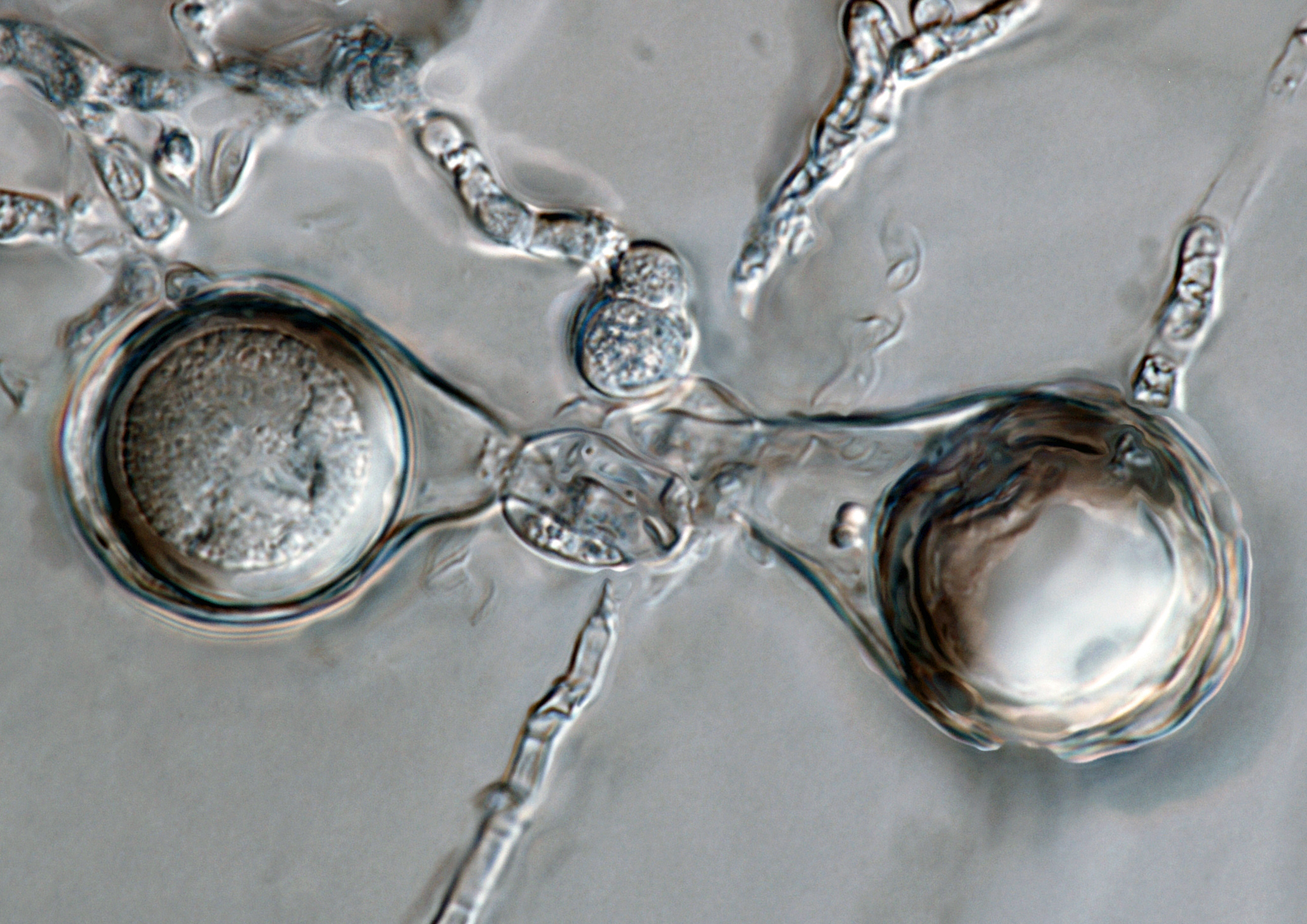 Phytophthora agathidicida nbsp;(ex-type CPHST BL 154) sexual phase formed on hemp seed agar: oogonia with wavy wall and tapered base,nbsp;amphyginous antheridia,nbsp;and plerotic, thick-walled oospores; photos by G.Abad, USDA-APHIS-PPQ.
Phytophthora agathidicida nbsp;(ex-type CPHST BL 154) sexual phase formed on hemp seed agar: oogonia with wavy wall and tapered base,nbsp;amphyginous antheridia,nbsp;and plerotic, thick-walled oospores; photos by G.Abad, USDA-APHIS-PPQ.
Phytophthora agathidicida (ex-type CPHST BL 154) sexual phase formed on hemp seed agar: oogonia with wavy wall and tapered base, amphyginous antheridia, and plerotic, thick-walled oospores; photos by G.Abad, USDA-APHIS-PPQ.
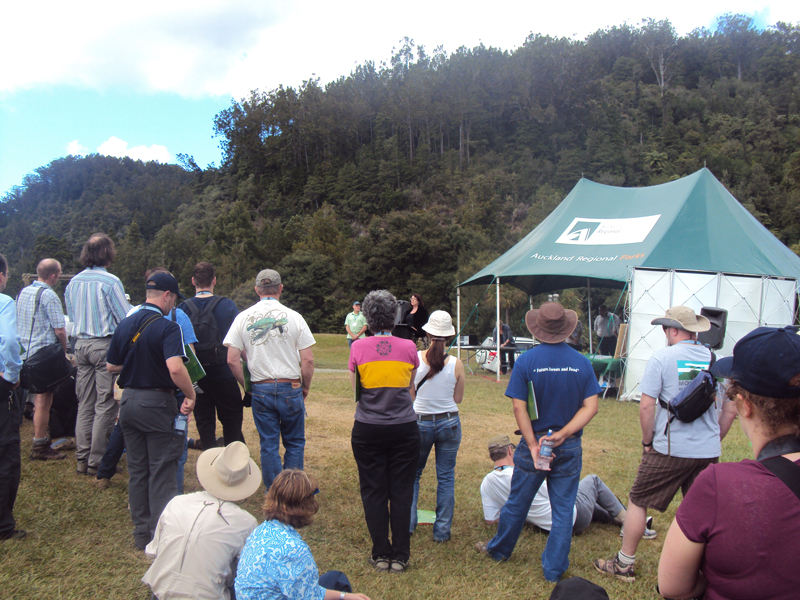 Participants of the 5th IUFRO Phytophthora in Forests and Natural Ecosystems Working Group (March 7-12, 2010, Auckland and Rotorua, New Zealand) attending a presentation at the Waitakere Ranges Regional Park, west of Auckland. At this location iconic native kauri ( Agathis australis ) trees were affected by ldquo;kauri diebackrdquo; caused by ldquo; Phytophthora taxon agathis rdquo;; photo by Gloria Abad, USDA-APHIS-PPQ.
Participants of the 5th IUFRO Phytophthora in Forests and Natural Ecosystems Working Group (March 7-12, 2010, Auckland and Rotorua, New Zealand) attending a presentation at the Waitakere Ranges Regional Park, west of Auckland. At this location iconic native kauri ( Agathis australis ) trees were affected by ldquo;kauri diebackrdquo; caused by ldquo; Phytophthora taxon agathis rdquo;; photo by Gloria Abad, USDA-APHIS-PPQ.
Participants of the 5th IUFRO Phytophthora in Forests and Natural Ecosystems Working Group (March 7-12, 2010, Auckland and Rotorua, New Zealand) attending a presentation at the Waitakere Ranges Regional Park, west of Auckland. At this location iconic native kauri (Agathis australis) trees were affected by “kauri dieback” caused by “Phytophthora taxon agathis”; photo by Gloria Abad, USDA-APHIS-PPQ.
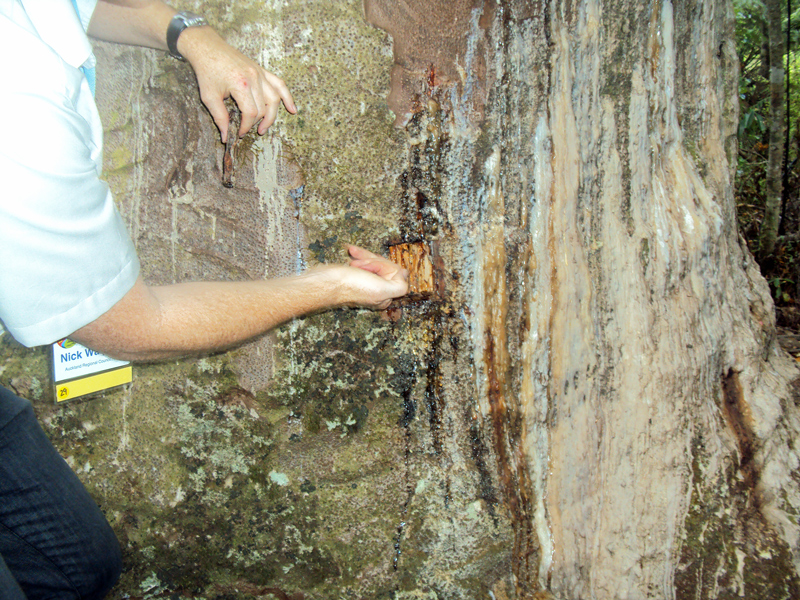 Kauri giant tree with symptoms of bleeding canker. The New Zealand expert holds in the left hand a piece of the cortex that will be replaced, in respect of indigenous Maori traditions. Kauri holds a very significant place in their creation mythology, with the iconic trees having their own names, for example Tane-mahuta ldquo;the God of the Forestrdquo;; photo by Gloria Abad, USDA-APHIS-PPQ.
Kauri giant tree with symptoms of bleeding canker. The New Zealand expert holds in the left hand a piece of the cortex that will be replaced, in respect of indigenous Maori traditions. Kauri holds a very significant place in their creation mythology, with the iconic trees having their own names, for example Tane-mahuta ldquo;the God of the Forestrdquo;; photo by Gloria Abad, USDA-APHIS-PPQ.
Kauri giant tree with symptoms of bleeding canker. The New Zealand expert holds in the left hand a piece of the cortex that will be replaced, in respect of indigenous Maori traditions. Kauri holds a very significant place in their creation mythology, with the iconic trees having their own names, for example Tane-mahuta “the God of the Forest”; photo by Gloria Abad, USDA-APHIS-PPQ.
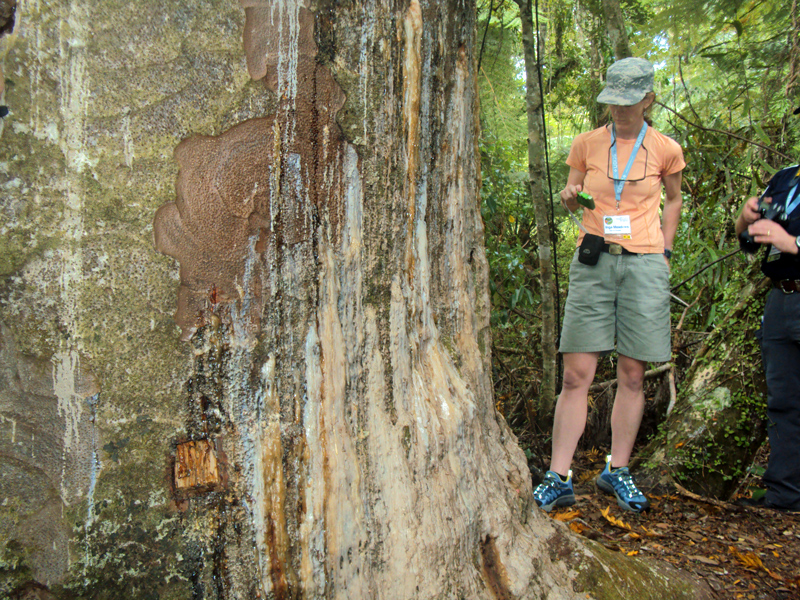 kauri ( Agathis australis ) giant tree with symptoms of bleeding canker; photo by Gloria Abad,nbsp;USDA-APHIS-PPQnbsp;
kauri ( Agathis australis ) giant tree with symptoms of bleeding canker; photo by Gloria Abad,nbsp;USDA-APHIS-PPQnbsp;
kauri (Agathis australis) giant tree with symptoms of bleeding canker; photo by Gloria Abad, USDA-APHIS-PPQ
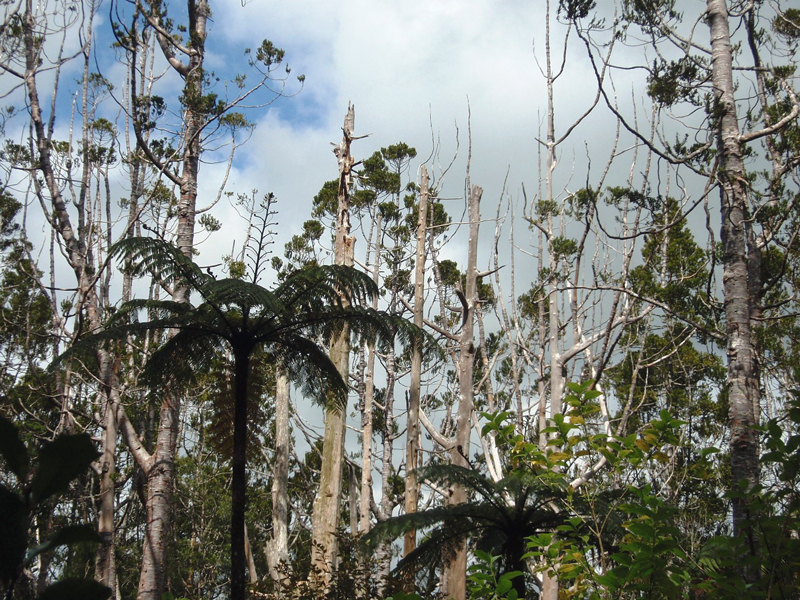 Kauri dieback, caused by Phytophthora agathidicida , is specific to New Zealand kauri and can kill trees of all ages; photo courtesy of Kauri Dieback Programme Partners, New Zealand.
Kauri dieback, caused by Phytophthora agathidicida , is specific to New Zealand kauri and can kill trees of all ages; photo courtesy of Kauri Dieback Programme Partners, New Zealand.
Kauri dieback, caused by Phytophthora agathidicida, is specific to New Zealand kauri and can kill trees of all ages; photo courtesy of Kauri Dieback Programme Partners, New Zealand.
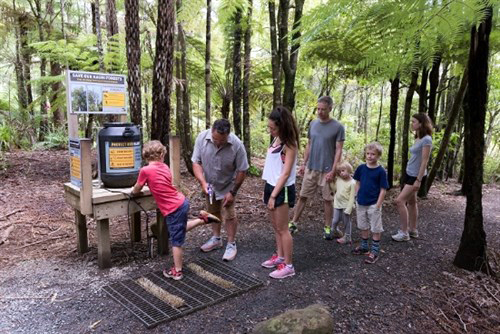 Taking action to prevent the spread of kauri dieback,nbsp;caused by Phytophthora agathidicida ; photo courtesy ofnbsp;Kauri Dieback Programme Partners, New Zealand.
Taking action to prevent the spread of kauri dieback,nbsp;caused by Phytophthora agathidicida ; photo courtesy ofnbsp;Kauri Dieback Programme Partners, New Zealand.
Taking action to prevent the spread of kauri dieback, caused by Phytophthora agathidicida; photo courtesy of Kauri Dieback Programme Partners, New Zealand.
Phytophthora spp. in subclade 1a: portion of the seven-loci ML phylogeny featuring the type cultures of 212 described species (by T. Bourret). Notice the position of P. aleatoria Ex-type NZFS 4037. Gloria Abad, USDA S&T.
Phytophthora spp. in subclade 1a: Morphological Tabular key (PDF) and Tabular key legends (PDF) in IDphy2 KEY SECTION. Notice the data of P. aleatoria Ex-type NZFS 4037. Gloria Abad, USDA S&T.
colony morphology after 7 d growth at 20ºC on V8A, MEA, and PDA agar (from left to right)
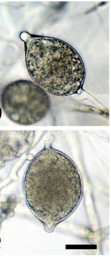 persistent and caducous, papillate, predominantly ovoid and limoniform sporangia mdash; scale bar = 20micro;m
persistent and caducous, papillate, predominantly ovoid and limoniform sporangia mdash; scale bar = 20micro;m
persistent and caducous, papillate, predominantly ovoid and limoniform sporangia — scale bar = 20µm
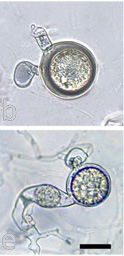 oogonia with smooth walls containing aplerotic oospores; antheridia can be both amphigynous and paragynous mdash; scale bar = 20micro;m
oogonia with smooth walls containing aplerotic oospores; antheridia can be both amphigynous and paragynous mdash; scale bar = 20micro;m
oogonia with smooth walls containing aplerotic oospores; antheridia can be both amphigynous and paragynous — scale bar = 20µm
 stem bleeding cankers associated with P. aleatoria on five-year-old Pinus radiata trees growing in Motueka Gorge, in the Nelson region; and b branch die-back with a canker on a two-year-old P. radiata tree in Nelson, associated with Phytophthora aleatoria
stem bleeding cankers associated with P. aleatoria on five-year-old Pinus radiata trees growing in Motueka Gorge, in the Nelson region; and b branch die-back with a canker on a two-year-old P. radiata tree in Nelson, associated with Phytophthora aleatoria
stem bleeding cankers associated with P. aleatoria on five-year-old Pinus radiata trees growing in Motueka Gorge, in the Nelson region; and b branch die-back with a canker on a two-year-old P. radiata tree in Nelson, associated with Phytophthora aleatoria
Phytophthora spp. in subclade 1a: portion of the seven-loci ML phylogeny featuring the type cultures of 212 described species (by T. Bourret). Notice the position of P. alpina Ex-type CBS 146801 = S&T BL 205. Gloria Abad, USDA S&T.
Phytophthora spp. in subclade 1a: Morphological Tabular key (PDF) and Tabular key legends (PDF) in IDphy2 KEY SECTION. Notice the data of P. alpina Ex-type CBS 146801 = S&T BL 205. Gloria Abad, USDA S&T.
Phytophthora spp. in Clade 4: portion of the seven-loci ML phylogeny featuring the type cultures of 212 described species (by T. Bourret). Notice the position of P. alticola Ex-neotype CBS 141718. Gloria Abad, USDA S&T.
Phytophthora spp. in Clade 4: Morphological Tabular key (PDF) and Tabular key legends (PDF) in IDphy2 KEY SECTION. Notice the data of P. alticola Ex-type CBS 141718. Gloria Abad, USDA S&T.
 colony morphology after 7 days growth at 20ordm;C onnbsp;CA, V8A, frac12; PDA, and MEA (left to right)
colony morphology after 7 days growth at 20ordm;C onnbsp;CA, V8A, frac12; PDA, and MEA (left to right)
colony morphology after 7 days growth at 20ºC on CA, V8A, ½ PDA, and MEA (left to right)
oogonia with wavy margins and aplerotic oospores with paragynous antheridia, scale bar = 20 µm
Phytophthora spp. in subclade 2b: portion of the seven-loci ML phylogeny featuring the type cultures of 212 described species (by T. Bourret). Notice the position of P. amaranthi Ex-type CH30042 = S&T BL 174. Gloria Abad, USDA S&T.
Phytophthora spp. in subclade 2b: Morphological Tabular key (PDF) and Tabular key legends (PDF) in IDphy2 KEY SECTION. Notice the data of P. amaranthi Ex-type CH30042 = S&T BL 174. Gloria Abad, USDA S&T.
 Phytophthora amaranthi (CPHST BL 174) colonies of the ex-type grown for 7 days on (a) V8reg; Agar, (b) potato dextrose agar, and (c) malt extract agar; photo by Krysta Jennings and Leandra Knight, USDA-APHIS-PPQ
Phytophthora amaranthi (CPHST BL 174) colonies of the ex-type grown for 7 days on (a) V8reg; Agar, (b) potato dextrose agar, and (c) malt extract agar; photo by Krysta Jennings and Leandra Knight, USDA-APHIS-PPQ
Phytophthora amaranthi (CPHST BL 174) colonies of the ex-type grown for 7 days on (a) V8® Agar, (b) potato dextrose agar, and (c) malt extract agar; photo by Krysta Jennings and Leandra Knight, USDA-APHIS-PPQ
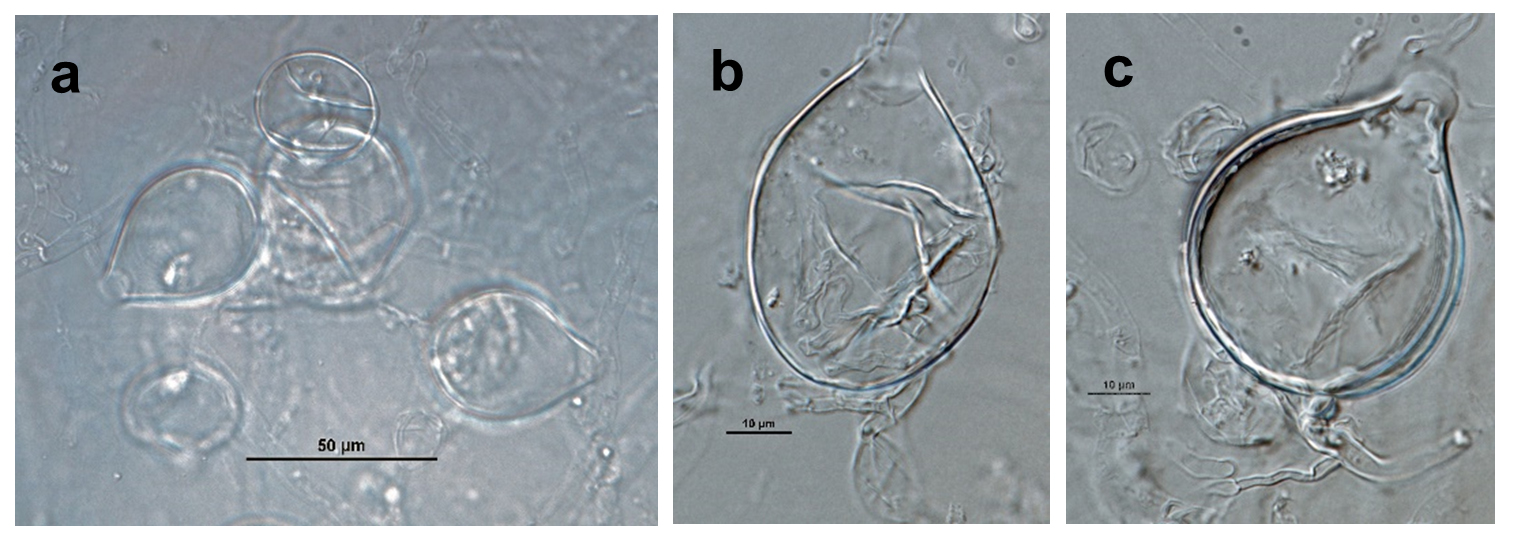 Phytophthora amaranthinbsp; (ex-type CPHST BL 174) asexual phase: (a-c) papillate and semipapillate sporangia; photos by Gloria Abad, USDA-APHIS-PPQ.
Phytophthora amaranthinbsp; (ex-type CPHST BL 174) asexual phase: (a-c) papillate and semipapillate sporangia; photos by Gloria Abad, USDA-APHIS-PPQ.
Phytophthora amaranthi (ex-type CPHST BL 174) asexual phase: (a-c) papillate and semipapillate sporangia; photos by Gloria Abad, USDA-APHIS-PPQ.
 Phytophthora amaranthi nbsp;(ex-type CPHST BL 174) homothallic sexual phase: (a-e) smooth-walled oogonia with amphigynous antheridia and aplerotic oospores; photos by Gloria Abad, USDA-APHIS-PPQ.
Phytophthora amaranthi nbsp;(ex-type CPHST BL 174) homothallic sexual phase: (a-e) smooth-walled oogonia with amphigynous antheridia and aplerotic oospores; photos by Gloria Abad, USDA-APHIS-PPQ.
Phytophthora amaranthi (ex-type CPHST BL 174) homothallic sexual phase: (a-e) smooth-walled oogonia with amphigynous antheridia and aplerotic oospores; photos by Gloria Abad, USDA-APHIS-PPQ.
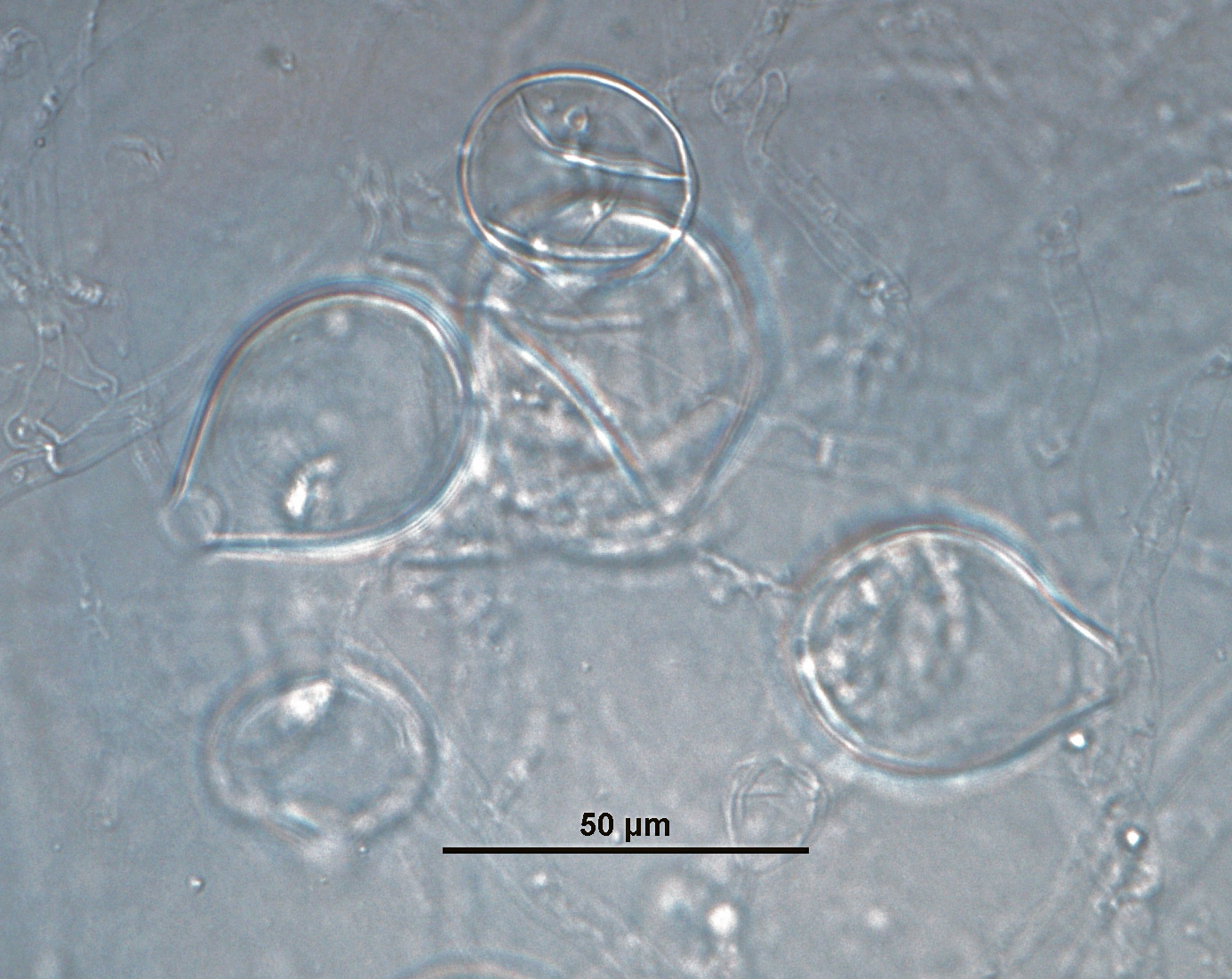 Phytophthora amaranthinbsp; (ex-type CPHST BL 174) asexual phase:nbsp;papillate and semipapillate sporangia; photos by Gloria Abad, USDA-APHIS-PPQ.
Phytophthora amaranthinbsp; (ex-type CPHST BL 174) asexual phase:nbsp;papillate and semipapillate sporangia; photos by Gloria Abad, USDA-APHIS-PPQ.
Phytophthora amaranthi (ex-type CPHST BL 174) asexual phase: papillate and semipapillate sporangia; photos by Gloria Abad, USDA-APHIS-PPQ.
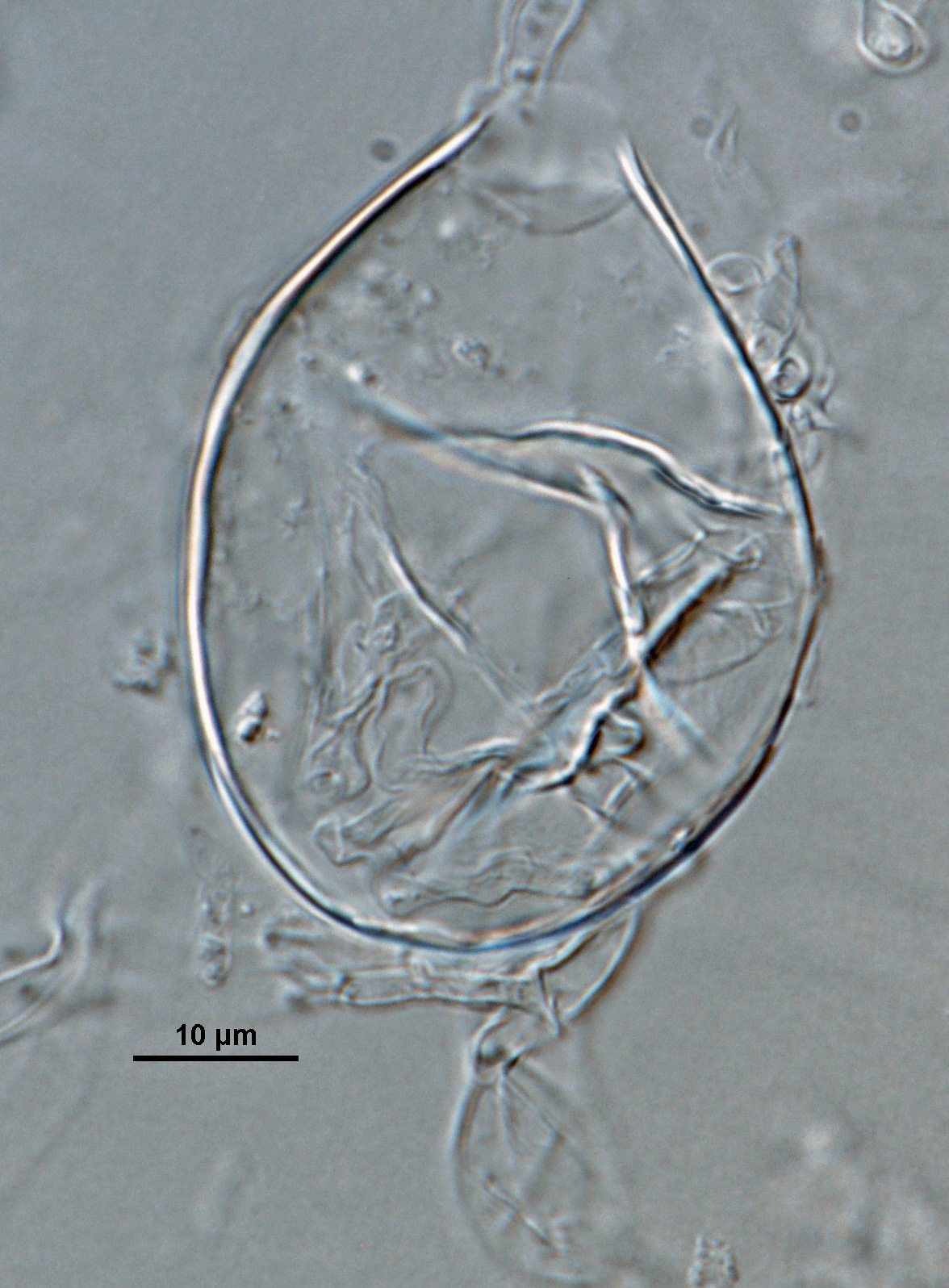 Phytophthora amaranthinbsp; (ex-type CPHST BL 174) asexual phase:nbsp;papillate and semipapillate sporangium; photos by Gloria Abad, USDA-APHIS-PPQ.
Phytophthora amaranthinbsp; (ex-type CPHST BL 174) asexual phase:nbsp;papillate and semipapillate sporangium; photos by Gloria Abad, USDA-APHIS-PPQ.
Phytophthora amaranthi (ex-type CPHST BL 174) asexual phase: papillate and semipapillate sporangium; photos by Gloria Abad, USDA-APHIS-PPQ.
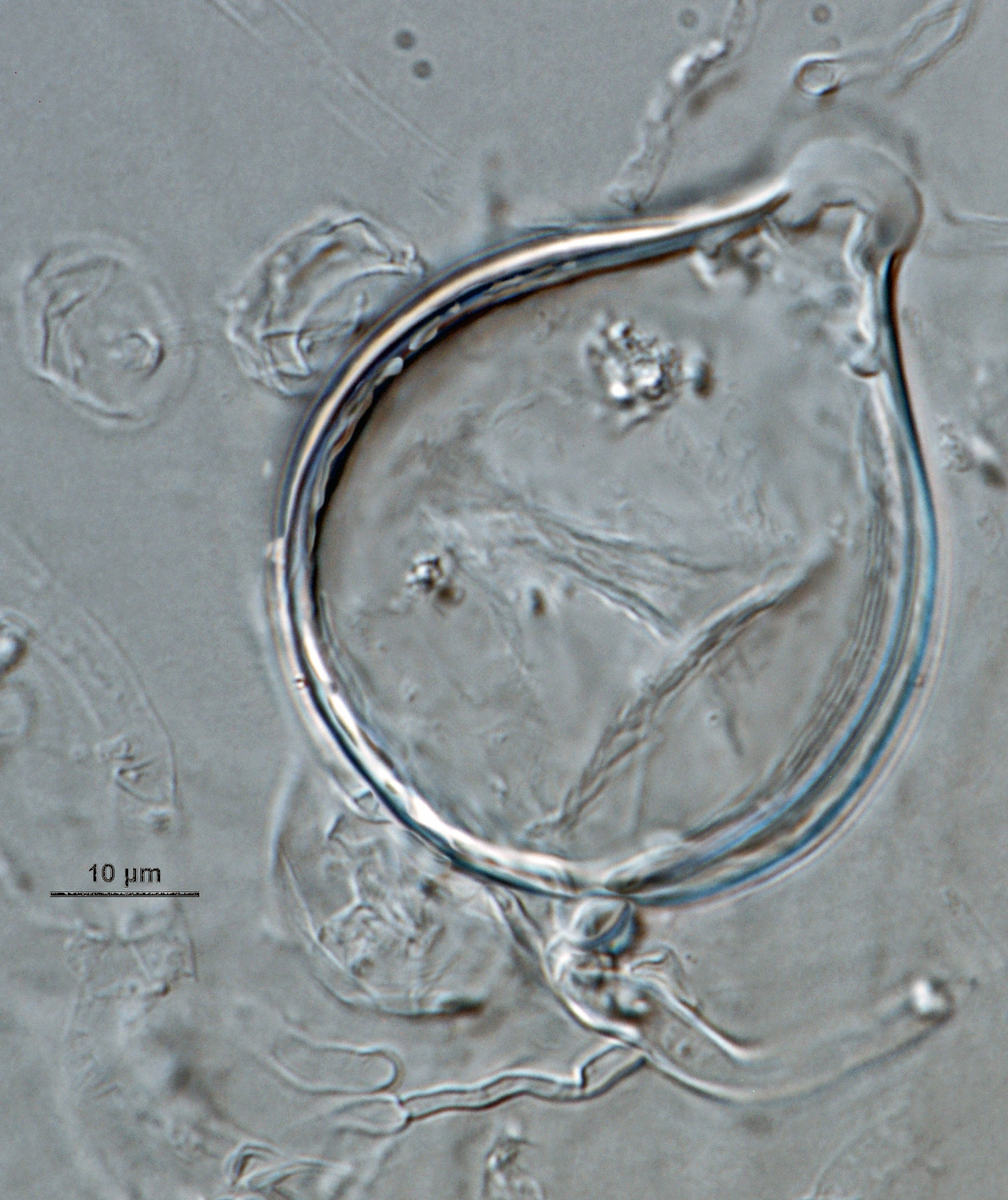 Phytophthora amaranthinbsp; (ex-type CPHST BL 174) asexual phase: papillate and semipapillate sporangium; photos by Gloria Abad, USDA-APHIS-PPQ.
Phytophthora amaranthinbsp; (ex-type CPHST BL 174) asexual phase: papillate and semipapillate sporangium; photos by Gloria Abad, USDA-APHIS-PPQ.
Phytophthora amaranthi (ex-type CPHST BL 174) asexual phase: papillate and semipapillate sporangium; photos by Gloria Abad, USDA-APHIS-PPQ.
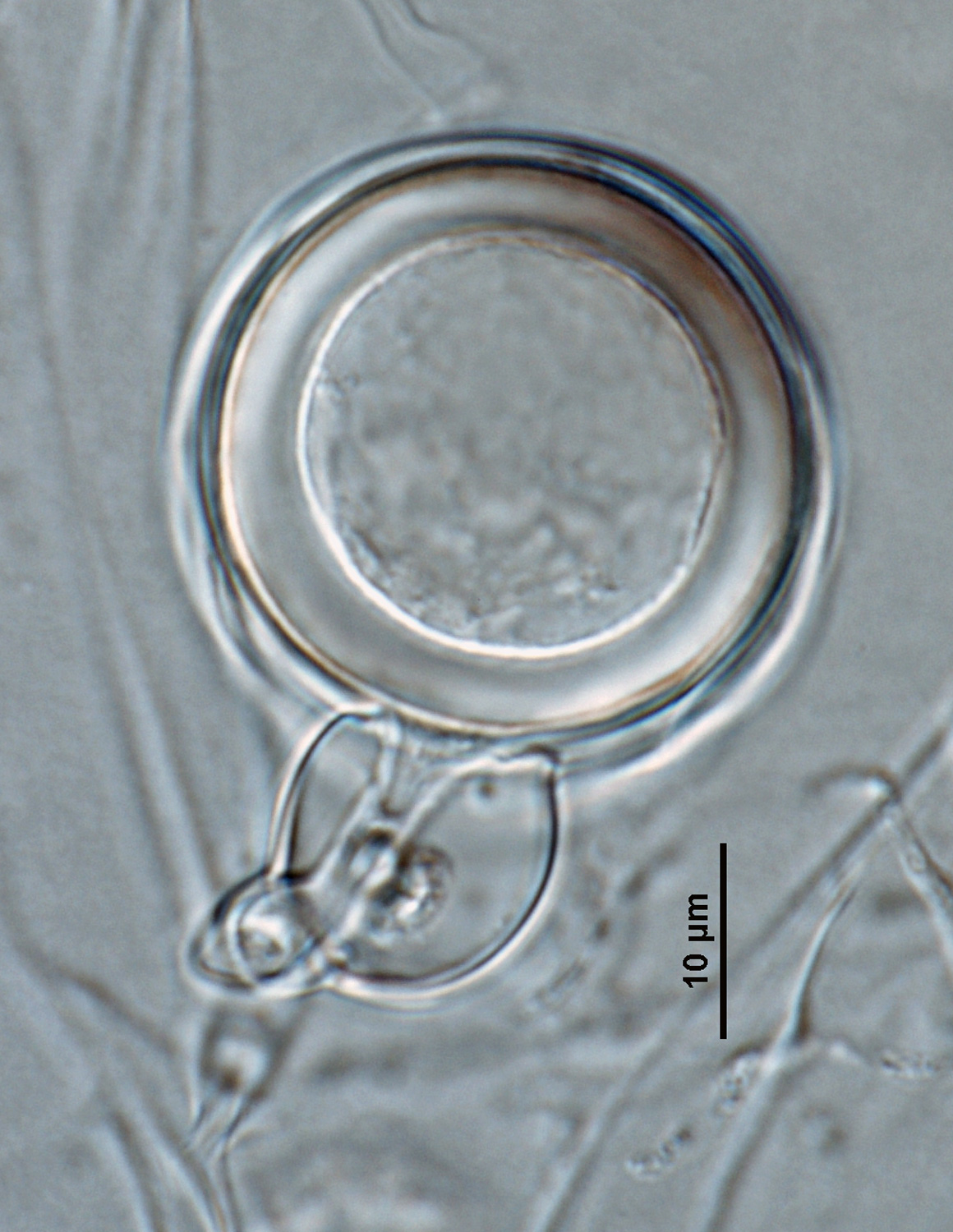 Phytophthora amaranthi nbsp;(ex-type CPHST BL 174) homothallic sexual phase:nbsp;smooth-walled oogoniumnbsp;with amphigynous antheridiumnbsp;and aplerotic oospore; photonbsp;by Gloria Abad, USDA-APHIS-PPQ.
Phytophthora amaranthi nbsp;(ex-type CPHST BL 174) homothallic sexual phase:nbsp;smooth-walled oogoniumnbsp;with amphigynous antheridiumnbsp;and aplerotic oospore; photonbsp;by Gloria Abad, USDA-APHIS-PPQ.
Phytophthora amaranthi (ex-type CPHST BL 174) homothallic sexual phase: smooth-walled oogonium with amphigynous antheridium and aplerotic oospore; photo by Gloria Abad, USDA-APHIS-PPQ.
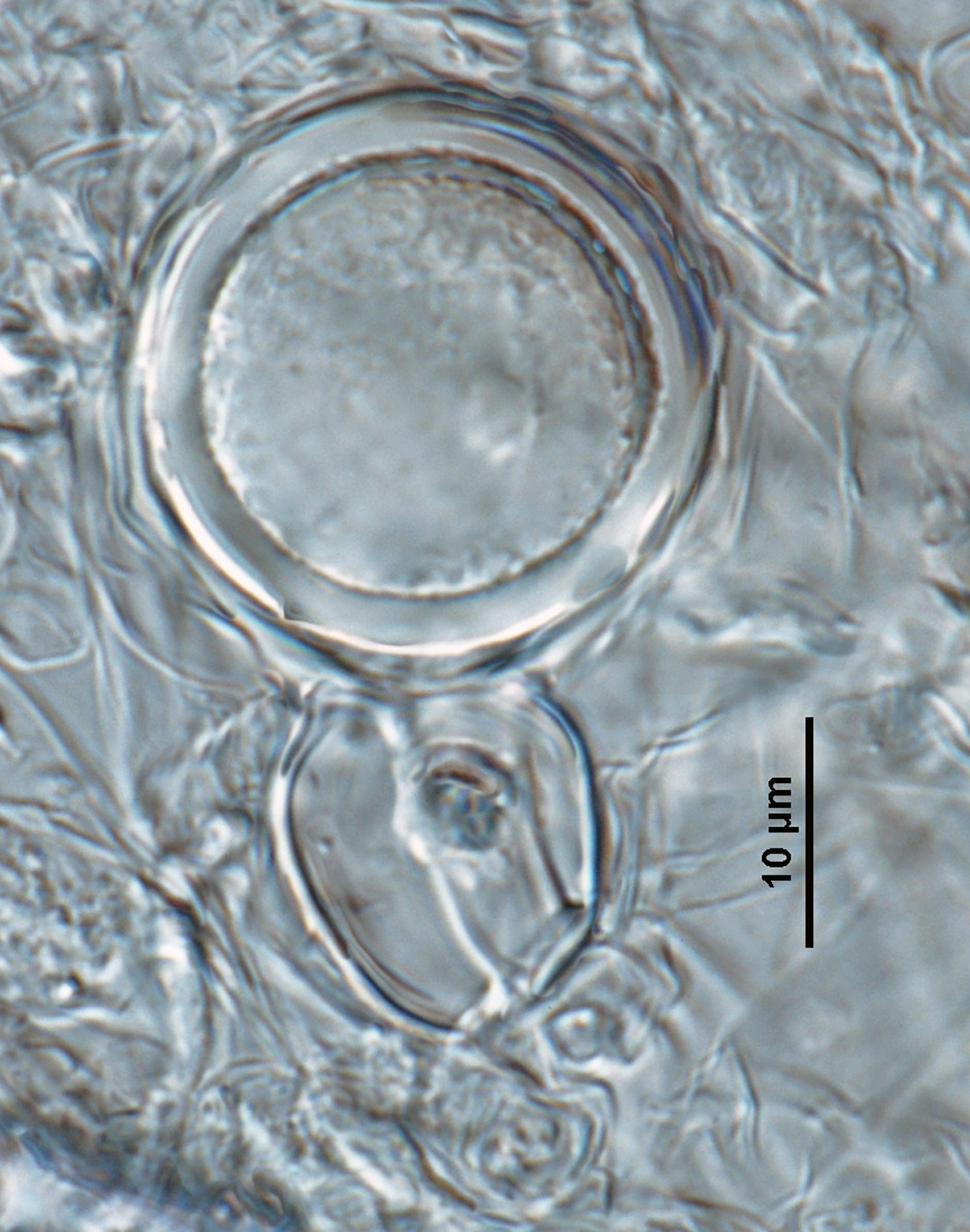 Phytophthora amaranthi nbsp;(ex-type CPHST BL 174) homothallic sexual phase: smooth-walled oogoniumnbsp;with amphigynous antheridiumnbsp;and aplerotic oospore; photonbsp;by Gloria Abad, USDA-APHIS-PPQ.
Phytophthora amaranthi nbsp;(ex-type CPHST BL 174) homothallic sexual phase: smooth-walled oogoniumnbsp;with amphigynous antheridiumnbsp;and aplerotic oospore; photonbsp;by Gloria Abad, USDA-APHIS-PPQ.
Phytophthora amaranthi (ex-type CPHST BL 174) homothallic sexual phase: smooth-walled oogonium with amphigynous antheridium and aplerotic oospore; photo by Gloria Abad, USDA-APHIS-PPQ.
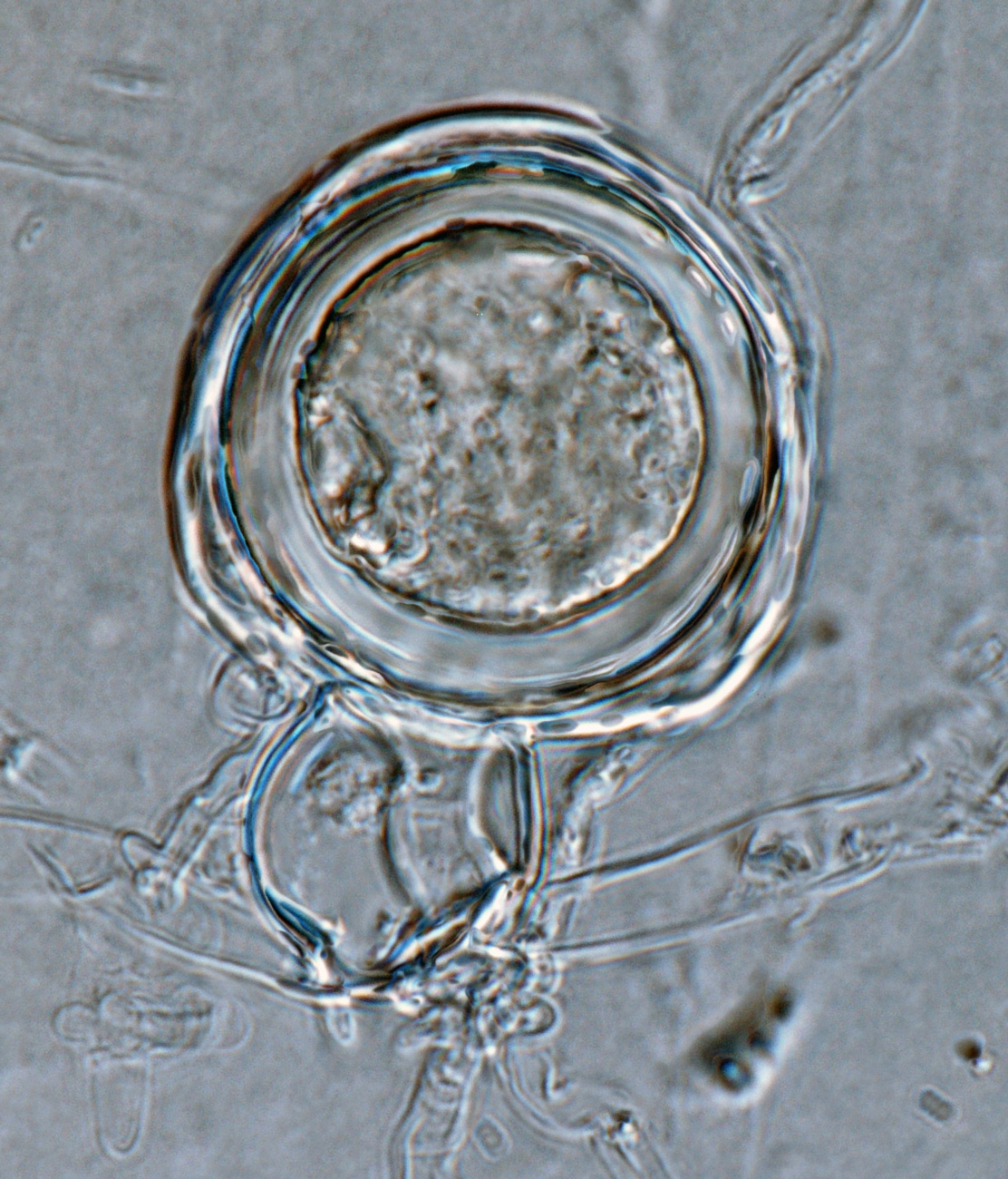 Phytophthora amaranthi nbsp;(ex-type CPHST BL 174) homothallic sexual phase:nbsp;smooth-walled oogoniumnbsp;with amphigynous antheridiumnbsp;and aplerotic oospore; photonbsp;by Gloria Abad, USDA-APHIS-PPQ.
Phytophthora amaranthi nbsp;(ex-type CPHST BL 174) homothallic sexual phase:nbsp;smooth-walled oogoniumnbsp;with amphigynous antheridiumnbsp;and aplerotic oospore; photonbsp;by Gloria Abad, USDA-APHIS-PPQ.
Phytophthora amaranthi (ex-type CPHST BL 174) homothallic sexual phase: smooth-walled oogonium with amphigynous antheridium and aplerotic oospore; photo by Gloria Abad, USDA-APHIS-PPQ.
 Phytophthora amaranthi nbsp;(ex-type CPHST BL 174) homothallic sexual phase:nbsp;smooth-walled oogoniumnbsp;with amphigynous antheridiumnbsp;and aplerotic oospore; photonbsp;by Gloria Abad, USDA-APHIS-PPQ.
Phytophthora amaranthi nbsp;(ex-type CPHST BL 174) homothallic sexual phase:nbsp;smooth-walled oogoniumnbsp;with amphigynous antheridiumnbsp;and aplerotic oospore; photonbsp;by Gloria Abad, USDA-APHIS-PPQ.
Phytophthora amaranthi (ex-type CPHST BL 174) homothallic sexual phase: smooth-walled oogonium with amphigynous antheridium and aplerotic oospore; photo by Gloria Abad, USDA-APHIS-PPQ.
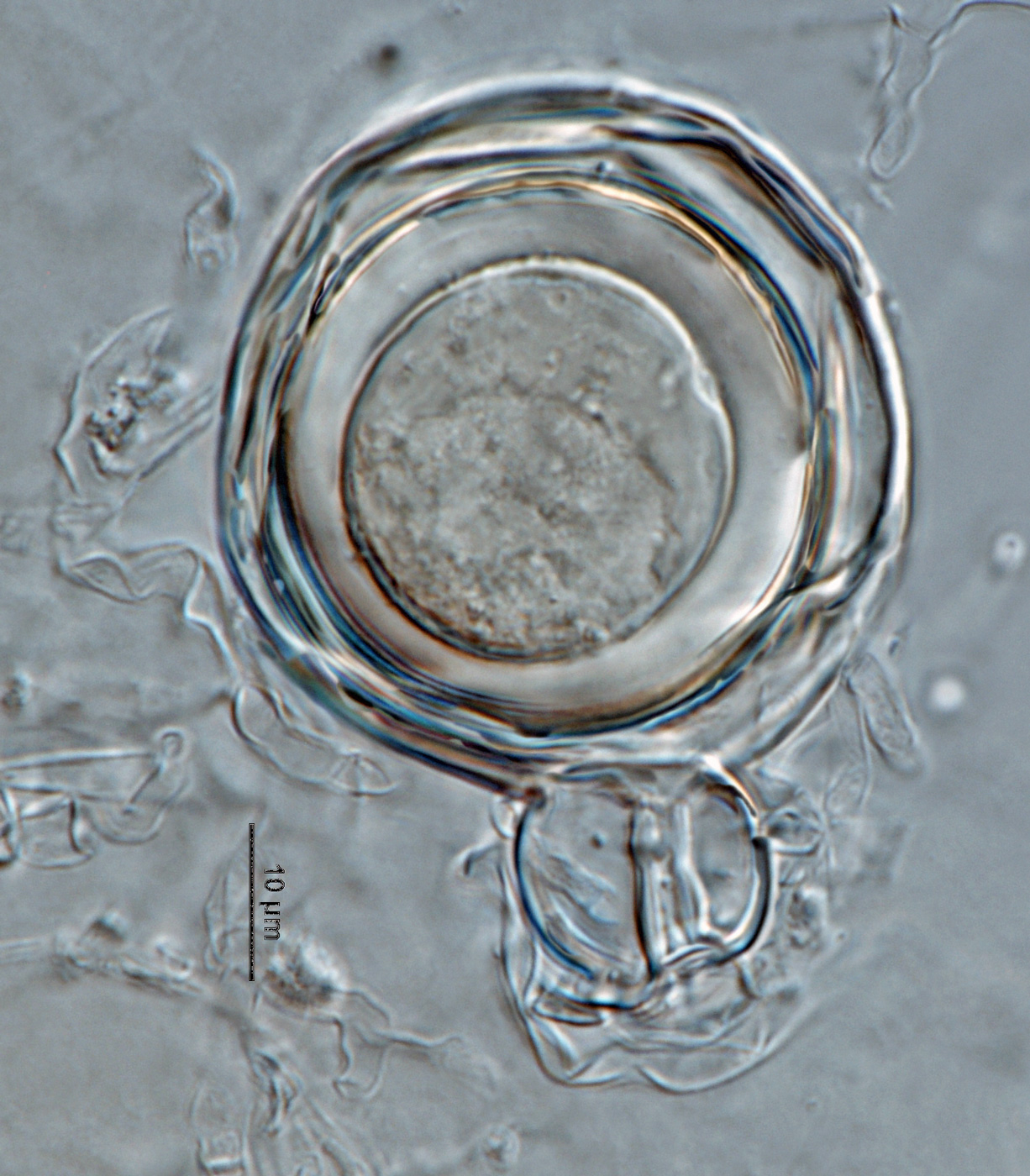 Phytophthora amaranthi nbsp;(ex-type CPHST BL 174) homothallic sexual phase:nbsp;smooth-walled oogoniumnbsp;with amphigynous antheridiumnbsp;and aplerotic oospore; photonbsp;by Gloria Abad, USDA-APHIS-PPQ.
Phytophthora amaranthi nbsp;(ex-type CPHST BL 174) homothallic sexual phase:nbsp;smooth-walled oogoniumnbsp;with amphigynous antheridiumnbsp;and aplerotic oospore; photonbsp;by Gloria Abad, USDA-APHIS-PPQ.
Phytophthora amaranthi (ex-type CPHST BL 174) homothallic sexual phase: smooth-walled oogonium with amphigynous antheridium and aplerotic oospore; photo by Gloria Abad, USDA-APHIS-PPQ.

